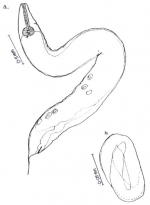NEIHPID
North-East India Helminth Parasite Information Database
Recently added
Parasites
Molecular Data
Oxysomatium sp.
Taxonomy
Nematoda »
SECERNENTEA »
Cosmocercidae (Railliet, 1916) Travassos, 1925 »
Cosmocercinae Railliet, 1916 »
Oxysomatium Railliet et Henry, 1916 »
Oxysomatium sp.
Host
Amolops (marmoratus (A. afghanus)), Bufo (melanostictus), Eburana (chloronata (=Rana livida)), Euphlyctis (cyanophlyctis), Haplobatrachus (tigerinus), Hyla (annectans), Limnonectes (limnocharis), Microhyla (ornata), Philautus (sp.), Philautus (shillongensis), Philautus (annandallii), Polypedates (leucomystax), Rana (nagalandensis), Rana (khare), Rana (danieli), Rhacophorus (bipunctatus(=R. reinwardtii)), Rhacophorus (maximus (=R. nigropalmatus))
Habitat
Intestine
Locality
Nongpoh (Meghalaya), Dawki (Meghalaya), Umkiang (Meghalaya), Lumshnong (Meghalaya), Shillong (Meghalaya), Smit (Meghalaya), Umtyngar (Meghalaya), Mawsynram (Meghalaya), Mairang (Meghalaya), Jowai (Meghalaya), Laitkor (Meghalaya), Jongksha (Meghalaya), Dimapur (Nagaland), Kohima (Nagaland), Mokokchung (Nagaland), Zunheboto (Nagaland)
Description
Medium-sized worms, 3.375-3.74 mm in length, 0.172-0.244 mm in maximum width; cuticular striations present. Mouth with three simple inconspicuous lips. Oesophagus long, containing pharynx and clearly separated subglobular bulb with definite valvular apparatus. Lateral alae absent, caudal alae prominent. Vulva at about middle of body or somewhat behind it. Amphidelphic condition of uterus. Eggs few, medium-sized, oval, many of them containing larvae (ovoviviparous condition), 0.063-0.086 x 0.039-0.054 mm in size.
Remarks
On account of the oesophagus having a posterior bulb, vulva at about middle of body, amphidelphic uterus and eggs containing embryo (ovoviviparous condition) the present form is relegated to the genus Oxysomatium. Since only females of this form occurred in the collection, species status could not be reached. These specimens differed from the females of Oxysomatium macintoshii mainly in having more body length, number and size of eggs (more numerous and smaller than in O. macintoshii) and ovoviviparous condition of the worms.
Helminthological collections record
NEHU/Z - NA/5



.jpg)
